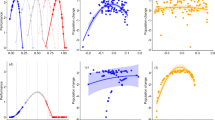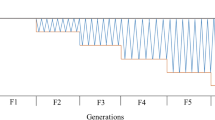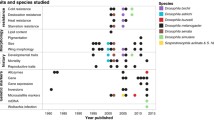Abstract
Species with restricted distributions make up the vast majority of biodiversity. Recent evidence from Drosophila suggests that species with restricted distributions may simply lack genetic variation in key traits, limiting their ability to adapt to conditions beyond their current range. Specifically, tropical species of Drosophila have been shown to have low means and low genetic variation for cold tolerance and desiccation tolerance. It has therefore been predicted that these species will be limited in their response to future climatic changes. However whether these results extend beyond Drosophila is not known. We assess levels of quantitative genetic variation for cold tolerance and body size in three species of butterfly from the genus Eurema that can be classified as tropically restricted (E. laeta), tropical/subtropical (E. hecabe) and widespread (E. smilax) in their distribution. Compared to the more widely distributed species, we show that the tropically restricted E. laeta has significantly lower mean cold tolerance and lacks genetic variation for this trait. Thus, we empirically confirm in non-model organisms that low levels of genetic variation in a key ecological trait may play a role in limiting the distribution of tropically restricted species.



Similar content being viewed by others
References
Addo-Bediako A, Chown SL, Gaston KJ (2000) Thermal tolerance, climatic variability and latitude. Proc R Soc Lond Ser B 267:739–745
Blows M, Hoffmann AA (2005) A reassessment of genetic limits to evolutionary change. Ecology 86:1371–1384
Braby MF (2000) The butterflies of Australia. Their identification, biology and distribution. CSIRO Publishing, Canberra
Buckley LB, Butlin RK, Bridle JR (2012) Evidence for evolutionary change associated with the recent range expansion of the British butterfly, Aricia agestis, in response to climate change. Mol Ecol 21:267–280
Chown SL, Addo-Bediako A, Gaston KJ (2002) Physiological variation in insects: large-scale patterns and their implications. Comp Biochem Physiol B-Biochem Mol Biol 131:587
Crozier L (2003) Winter warming facilitates range expansion: cold tolerance of the butterfly Atalopedes campestris. Oecologia 135:648–656
Crozier L (2004a) Warmer winters drive butterfly range expansion by increasing survivorship. Ecology 85:231–241
Crozier L (2004b) Field transplants reveal summer constraints on a butterfly range expansion. Oecologia 141:148–157
Futuyma DJ (2010) Evolutionary constraint and ecological consequences. Evolution 64:1865–1884
Gibert P, Moreteau B, Petavy G, Karan D, David R (2001) Chill-coma tolerance, a major climatic adaptation among Drosophila species. Evolution 55:1063–1068
Hellmann JJ (2002) Butterflies as model systems for understanding and predicting climate change. Wildlife responses to climate change: North American case studies. Schneider SH, Root TL (ed), Island Press, Washington, 93–126
Hellmann JJ, Pelini SL, Prior KM, Dzurisin JDK (2008) The response of two butterfly species to climatic variation at the edge of their range and the implications for poleward range shifts. Oecologia 157:583–592
Jones RE (1992) Phenotypic variation in Australian Eurema species. Aust J Zool 40:371–383
Kellermann V, van Heerwaarden B, Hoffmann AA, Sgrò CM (2006) Very low additive genetic variance and evolutionary potential in multiple populations of two rainforest Drosophila species. Evolution 60:1104–1108
Kellermann V, van Heerwaarden B, Sgrò CM, Hoffmann AA (2009) Fundamental evolutionary limits in ecological traits drive Drosophila species distributions. Science 325:1244–1246
Kellermann V, Loeschcke V, Hoffmann AA, Kristensen TN, Flojgaard C, David JR, Svenning J-C, Overgaard J (2012a) Phylogenetic constraints in key functional traits behind species’ climate niches: patterns of desiccation and cold resistance across 95 Drosophila species. Evolution 66:3377–3389
Kellermann V, Overgaard J, Hoffmann AA, Flogaard C, Svenning J-C, Loeschcke V (2012b) Upper thermal limits of Drosophila are linked to species distributions and strongly constrained phylogenetically. Proc Natl Acad Sci USA 109:16228–16233
Kelly MW, Sanford E, Grosberg RK (2012) Limited potential for adaptation to climate change in a broadly distributed marine crustacean. Proc R Soc Lond Ser B 279:349–356
Kemp DJ (2008) Resource-mediated condition dependence in sexually dichromatic butterfly wing coloration. Evolution 62:2346–2358
Kemp DJ, Macedonia JM (2007) Male mating bias and its potential reproductive consequence in the butterfly Colias eurytheme. Behav Ecol Sociobiol 61:415–422
Kemp DJ, Rutowski RL (2007) Condition dependence, quantitative genetics, and the potential signal content of iridescent ultraviolet butterfly coloration. Evolution 61:168–183
Kimura MT (2004) Cold and heat tolerance of drosophilid flies with reference to their latitudinal distributions. Oecologia 149:442
Klemme I, Hanski I (2009) Heritability of and strong single gene (Pgi) effects on life-history traits in the Glanville fritillary butterfly. J Evol Biol 22:1944–1953
Lynch M, Walsh B (1998) Genetics and analysis of quantitative traits. Sinauer, Sunderland
McGuigan K, van Homrigh A, Blows MW (2008) An evolutionary limit to male mating success. Evolution 62:1528–1537
Parmesan C (2006) Ecological and evolutionary responses to recent climate change. Ann Rev Ecol Evol Syst 37:637–669
Parsons PA (1982) Evolutionary biology of Australian Drosophila—a species analysis. Evol Biol 14:297–350
Ransberry VE, MacMillan HA, Sinclair BJ (2011) The relationship between chill-coma onset and recovery at the extremes of the thermal window of Drosophila melanogaster. Physiol Biochem Zool 84:553–559
Thomas CD (2010) Climate, climate change and range boundaries. Divers Distrib 16:488–495
Van Herrewegge J, David JR (1997) Starvation and desiccation tolerances in Drosophila: comparison of species from different climatic origins. Ecoscience 4:151
Walther GR, Post E, Convey P, Menzel A, Parmesan C, Beebee TJC, Fromentin JM, Hoegh-Guldberg O, Bairlein F (2002) Ecological responses to recent climate change. Nature 416:389–395
Acknowledgments
We thank Ary Hoffmann for comments on an earlier version of this manuscript. We also thank two anonymous reviewers for their valuable comments. This study was supported by funding from the Australian Research Council via its Fellowship and Discovery Project schemes, and from the Science and Industry Engagement Fund. Macquarie University and Monash University provided additional financial support.
Author information
Authors and Affiliations
Corresponding author
Rights and permissions
About this article
Cite this article
Davis, J.M.P., van Heerwaarden, B., Sgrò, C.M. et al. Low genetic variation in cold tolerance linked to species distributions in butterflies. Evol Ecol 28, 495–504 (2014). https://doi.org/10.1007/s10682-013-9684-5
Received:
Accepted:
Published:
Issue Date:
DOI: https://doi.org/10.1007/s10682-013-9684-5




